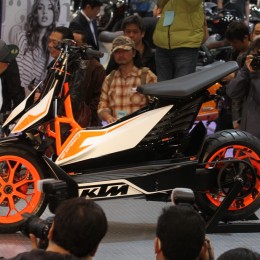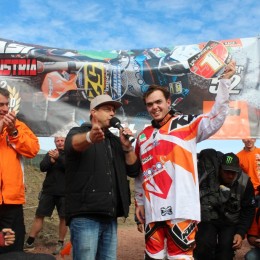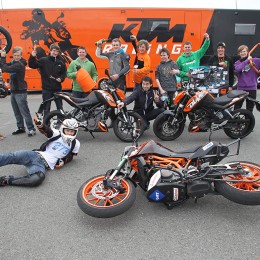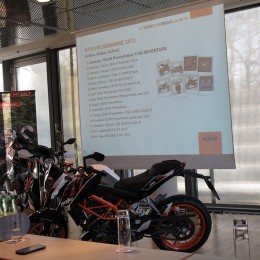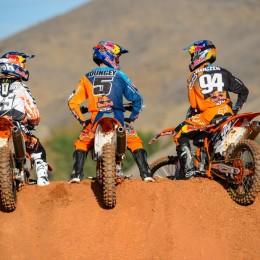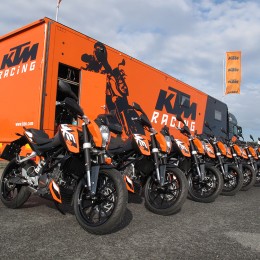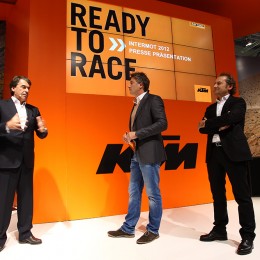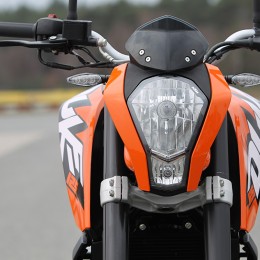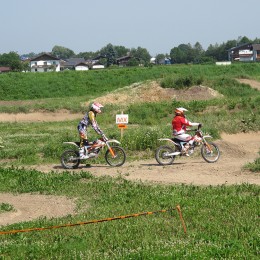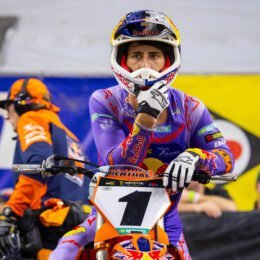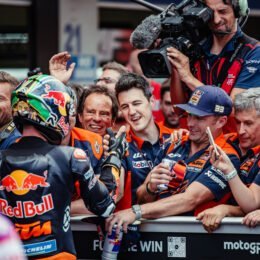Exclusive Stefan Pierer interview part three
In this final instalment of an exclusive chat about all things KTM with CEO Stefan Pierer ‘The Boss’ here talks about the creation process for new KTMs, electric bikes, KTM’s future and their current position in the motorcycle world and market…
So, you use Kiska for design…
It is a special relationship and it is difficult to explain. It is based on a long-term friendship and in the first decade it worked without any contract and Gerald started with one employee and is now Europe’s biggest independent design company with 120 people. A third of his work, sales or revenues are done with KTM consistently. It is very important that he is independent although we do have a small participation with 5-6% of the company. He is doing more than 50% of his work with other clients and based on that he gets input from other sources and that helps us to refresh and keep up with latest trends. If you have a standalone KTM designer or just an internal team like they do in Audi then they are not going to pick up those influences. There is not the freedom there, and I think that is one of the successful elements in our joint-story. The DNA of KTM has been consistent for twenty years. The customer must recognise you instantly. The colour is important but so are the design elements. The design is aggressive, the styling is edgy.
Do you personally give the final green light on projects?
It is a group thing, for sure. As the leading guy I have the possibility to interfere until the end but normally we define a project in a group and then it is running through a very precise procedure. For sure it gets checked and if it doesn’t look good then it can be stopped but on the other hand there are things that we say ‘forget the research and data, let’s do it. Let’s make a statement’.
Any examples of where you’ve put your personal input into a project?
Maybe if we go back to when we were moving aggressively into motocross…those bikes are very slim and the product is not that easy to identify as a brand. It is a motorcycle that is moving a lot and jumping. We wanted something you could recognise right away in the start gate and that was a clear message for Gerald. The number plate and the front fender must have a very characteristic KTM design…there’s an example. Before all the front fenders looked the same.
You mentioned about design using outside influences…does that apply to business as well when you need to look around and decide and predict where new models will sell and be popular? Is that part of your skill?
Maybe it is, and collecting opinions and ideas and filtering them. Fortunately our R&D and Marketing have so many ideas that they are doing it on their own. Sometimes you go into R&D and see something different and say ‘what’s that?!’ and they say they are trying something new and then you get a proposal on your desk for a new motorcycle concept. They are also going to a lot of races because on the track you get a good feel for what is going on and what might come in the future. Racing is a good information channel for KTM.
So in the same way a movie producer has scripts on his desk you have design proposals to go through?
Yeah! And there is an ongoing discussion with Gerald and that is the way we are doing it. For sure you have long term plans like small displacement engines and the regular annual facelifts to the product range but in terms of finding and creating new segments I think that is one of our successes.
The image of KTM in off-road seems like it is reaching a peak. The brand is synonymous with success in many disciplines. When you go back twenty-one years you must be happy with that achievement and that marketing strategy…
For sure and going back I can remember that Husqvarna was the benchmark for us in Enduro and motocross. It was a huge brand at the time and as a brand it is still alive. It was our main competitor back then. The Japanese for sure were there but Husqvarna were strong. Now in some segments we have a huge market share…but we are doing development in a very short period. This is one of the things I learned from the Japanese. They are doing innovation on a very regular basis and if you don’t follow then you lose ground, but you can overtake them if you deliver similar quality – because this is what the market needs – and you have a quicker rate of innovation. Taking more risks also, and this is the entrepreneur style, because things can take time in a big company but it is possible to beat them, even against someone like Honda…look at the Moto3 class. They have been influencing the rules for many years and know they have three years to make a very good product. If you don’t have a stable regulation, or the lead-time is much shorter, then they are struggling. In Moto3 they thought they had enough time to make a cheap bike that would be the same for everybody. We decided twelve months before the first race that we would enter Moto3, and try to beat Honda. It motivated the whole company. You can see what we delivered and now Honda is complaining that the sport is expensive and it is not part of their focus to deliver a winning product. They just lost the race, that’s all.
Compared to some other brands KTM has this image and marketing that is very powerful and with media and communications changing over the years the way to get the message across – and quickly – has become important…
I think for five years Gerald has also overseen marketing activities, communication and strategic guidance for the brand. He is very professional in that and we are measuring it. We want to become a global force and to enter Asian markets is a challenge for a small company. Although we are bigger than what we were, we are still challenging. We are 1800 people and in a year that might climb to 2000, we are clearing 120,000 units, we are doing 700 million euros in revenue and it sounds great but we have to go to Thailand and every country is totally different. Thailand is not Malaysia, Indonesia is different to Philippines and that’s a challenge for a small company but something that is very nice and of huge potential.
Is non-European expansion something you HAVE to do now, what with European bikes sales falling?
Absolutely. The European bike market has dropped 50% in five years and is still going down. After five months it is -7% on average. Half of the motorcycle sales season is gone and we can imagine what is coming. Every year it is becoming a very tough competition and you must take market share from others. The Asian markets are a bit different. KTM wasn’t there before because we only had our race bikes and sport bikes and were hobby items for some rich importers. Now we have the entry level bikes like the 125, 200 and 390 Duke coming on a price level that is competing against Honda and we are selling like hell; from zero to figures that we cannot believe. From the first five months we have quadrupled the numbers compared to last year in the Asian area. It is 30% ahead of 2012. It is because of the innovation rate and every half a year a new model is coming and in off-road we are still working very hard to improve every year. Sales and Marketing is doing a great job and production is keeping the quality high. Everything is in a good ‘rpm’ but you also have to take care not to go too fast because an increase of 25-30% means you are running on a edge in terms of people and capacity.
How is the 1190 Adventure doing in the market since its introduction?
Very successful. We are sold out this year with almost 7800 units gone, by far the double of what we had in previous years with the former model. With the new one we have arrived on the same level as the market leader and for the first time were able to gain new customers from other brands. Before it was more or less a hard-core, sporty KTM community on adventure trips but this time we got additional groups. For us the 1190 Adventure is also our state of the art bike because it is full of electronics, traction control, ABS and ride by wire; all the standard things on cars are also on the motorcycle. That is the platform for future models. The Super Duke 1290 that was launched at EICMA last winter, starts production in October and is based on the same electronics and you can roll it across the family.
E-bikes. When you first started the project did you have any idea how long it would take or how much money would be involved? Were you surprised?
If you knew everything before you do a project then you probably wouldn’t do anything! That’s the experience of an entrepreneur! Sometimes you have to go over the edge! The electric experience for us was different. It didn’t come out of the crisis but more from our heavily-squeezed possibilities now to ride off-road. In central Europe it is becoming difficult and the first concepts of e-bikes were seen as a possible and interesting solution. That was in ’05-’06. We decided to start a pre-development project to do an off-road bike based on a zero emission power train. We got good support from the Austrian Innovation Agency and then we started.
It took longer than I expected because I am used to combustion engine development but we didn’t give up and we created a good product that is now ready for serial production. The bottleneck and the biggest problem at a certain stage was getting the electronics right because there is no existing kind of system for that kind of power-train. This means we had to start from scratch for the balance of the battery and the engine management, and work on it together with a local specialist company. It was a tough trial-and-error process. The battery pack is still the main issue because they are expensive for production. A 20 kilo packed battery cell costs 2000 euros and is quite a lot. However it works and we have been testing for two years in various locations and with reliable clients at leisure parks. I think it is still not on a really competitive level in terms of the battery pack but for our special usage there is not much choice. Either you can afford it or you cannot. In Germany and Austria next year we will start a renting system for the battery like the car industry, so that the customer has the sense of security that if something goes wrong with the battery they can change it and they have 100% back-up. Every year we hope to expand the scope and tests. We have 100 years of experience with combustion engines but here we are still starting with electric and we need to collect information. For a small company you need to make a serious step with a project like this or you risk too much. We are going ahead and maybe you have seen some photos of our concept scooter from the Tokyo show. I am convinced that for urban mobility and the scooter electric is the future. It is just the double size of the existing battery for our off-road model.
How is development of the scooter coming along?
We have already started a serial project. For sure it will take two years from here, so we are looking at 2016 but we made the decision at management level to go ahead. The reaction is very positive and the demand is there. The fabrication and the chassis is not a big challenge. The battery pack is double the size and it is not quite double the cost but you are still looking at 3000 euros.
Do you think that is why the Japanese have not really show their hands yet when it comes to e-mobility?
Honda for sure are working on it and Yamaha have done a lot of research but the breakthrough in the market is not there. You have the cheap junk from China but they are low wattage concepts and if you want performance then you need to go high wattage to meet safety requirements and it is very tough and very challenging. The market is not there yet for mass production.
Do you think the Japanese are looking more and more at KTM now? Maybe in motocross for sure…
I think if you go to a track in Europe you can see some nice ‘red’ displays and branding like KTM did ten years ago and I think it is good that they are making the effort, putting in the money and a consequence of this is that the sport starts to get more attention. If you look at the motocross GPs in Brazil, France and Italy then there were big crowds. It was incredible to see and it was like motocross from twenty years ago. This is coming also a little bit from the crisis and pricewise you are getting more value because you can enter the paddock and you can see Tony Cairoli. That is the difference to Formula One and these other high-tech events. You are right though, people like Honda are taking the sport seriously and maybe they have seen us as a pain in the ass! Secondly I think they are looking at us in a different way after the combination with Bajaj and we are really hitting the emerging markets with outstanding products and new designs at affordable prices. From whom else should I obtain market share?


